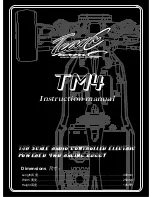
19
:: Tuning Tips (cont.)
Front Camber Links:
Changing the length of the camber link is considered a bigger step than
adjusting the ball end height on the tower. Shortening the camber link
(or lowering the ball end) will give the front end less roll and quicken steering
response. Lengthening the camber link (or raising the ball end) will give the
front more roll and slower steering response. Longer camber links are
typically used on high grip tracks and shorter links tend to work better on
medium-grip loose tracks.
*Raise or lower the
ball end by adding
or subtracting
washers here
!
Caster:
Caster describes the angle of the kingpin as it leans toward the rear of the vehicle. Positive caster means the kingpin
leans rearward at the top. The supplied 30° caster blocks (#7922) are recommended in most cases.
For less corner entry steering and more exit steering, try the optional 25° blocks (#7919).
Rear Camber Link:
Changing the length of the camber link is considered a bigger step than adjusting
the ball end height on the rear chassis brace. Shortening the camber link
(or lowering the ball end) will give the rear end less roll and the car will tend to
accelerate or “square up” better. Lengthening the camber link (or raising the ball
end) will give the rear more roll and more cornering grip. Longer camber links are
typically used on high grip tracks, while shorter links tend to work better on
medium grip loose tracks. The kit setting is the best compromise of cornering grip
and acceleration.
Wheelbase Adjustment:
You have three options for rear hub spacing, Forward, Middle, & Back.
The kit setting provides the most rear traction, and will be used most often.
For improved handling in bumps or rhythm sections, try moving the hubs to the
Middle or Back position. This can also make the car handle better in 180° turns.
Rear Camber:
Camber describes the angle at which the tire and wheel rides when looked at from the back. Negative camber means
that the tire leans inward at the top. A good starting camber setting is -1°. Use the included #1719 camber gauge to
set your camber. Adding a small amount of positive camber, where the top of the tire is leaning out, will tend to improve
straight-line acceleration on loose tracks.
Anti-Roll Bars:
The optional #9635 rear anti-roll bar kit (also called the “swaybar”) allows you to add roll resistance to the rear end with
minimal effect on handling over bumps and jumps. It is an especially helpful tuning item on high-grip tracks
(try the gold bar). The silver and black anti-roll bars are typically used on medium-grip loose tracks.
Ride Height:
Ride height is the distance from the ground to the bottom of the
chassis. The standard front ride height setting is with the inner
and outer hinge pins of the front arms level on the same imaginary
horizontal line, or 30mm as measured from the bottom of the
chassis directly behind the front bumper.
The rear ride height setting you should use most often is with the
outdrive, driveshaft, and axles all on the same imaginary horizontal
line (reffered to as “bones level”) or 28mm.
Check the ride height by lifting up the entire car about 8-12 inches
off the bench and drop it. After the suspension “settles” into place,
measure ride height (Ride Height Gauge #1449). Raise or lower
the shock collars as necessary.
Front Camber:
Camber describes the angle at which the tire and wheel rides when
looked at from the front. Negative camber means that the tire leans
inward at the top. A good starting camber setting is -1°. Use the
included #1719 camber gauge to set your camber. Positive camber,
where the top of the tire is leaning out, is not recommended.
*Testing camber
with camber gauge
!
*Raise or lower
the ball end by
adding or
subtracting
washers here
*Spacers to the rear
will place hubs for-
ward, shortening
the wheelbase
*Front arms
inner and outer
hinge pins should
be in a imaginary
horizontal line
when ride height
is set
*CVA bones should
be in a straight line
when ride height is
set at “CVA bones
level”
!
!
!
!
Summary of Contents for T4.2 Factory Team Kit
Page 1: ...12 12 ...
Page 30: ...30 Notes ...
















































